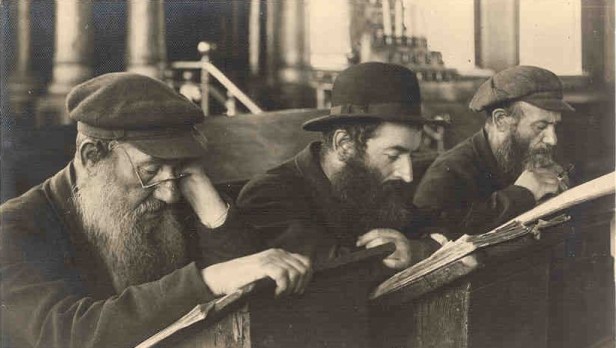
Renowned Rabbi and revered teacher to many of us, Steve Greenberg, recently performed the wedding ceremony of Yoni Block and Ron Kaplan at a Washington, D.C. synagogue. While it’s no longer a big deal to hear of a rabbi conducting a same-sex wedding ceremony, e.g. Reform rabbis have been doing it for a decade or more and many Conservative rabbis have come on board with the idea in recent years, it is still very unusual to hear of a rabbi with Orthodox ordination conducting such a ceremony.
It was my intention to simply post links to the video taken of Yoni and Ron’s wedding ceremony and offer a few supportive words about Rabbi Greenberg. But that effort got side-tracked when I engaged a critic of Rabbi Greenberg’s actions in the comment section of the YouTube page on which the video can be seen.
The primary objection posed by the apparently Orthodox person, was that by modifying the traditional Jewish wedding ceremony and ketubah (marriage contract), and by performing a traditional wedding ceremony for two men, Rabbi Greenberg was acting not only outside of the parameters of Orthodoxy, but “outside of the halachic process.” (Halacha = Jewish law.)
I am not a rabbi and make no claims to being a maven (expert) on the intricacies of Jewish law. But this exchange of ideas got me to thinking: so what is the halachic process? How is it supposed to operate? How does it actually operate and what is its ultimate purpose?
I will leave the technical nature of that discussion to rabbis and other lay-people more learned in the ways of Rabbinic Judaism. But I do feel comfortable posing some questions to my Orthodox brothers and sisters about what they deem as the “legitimate” process in which halacha operates:
posing some questions to my Orthodox brothers and sisters about what they deem as the “legitimate” process in which halacha operates:
- Is the Orthodox halachic process about insuring the validity and vitality of Jewish law, or is it all about maintaining the social and cultural norms of the Orthodox community?
- Is the Orthodox halachic process about informing, educating and engaging Jews in a sacred effort that ponders the will of God? Or is the process more focused on determining “do’s and don’ts?”
- Is the Orthodox halachic process about helping the Jewish people maintain their part of the covenant with God by making Jewish law accessible, relevant and meaningful, or is about creating boundaries that limit debate, lifestyles and gender roles?
- Is the Orthodox halachic process open to incorporating new knowledge about the human condition into age-old interpretations and applications of Jewish law? Or is new information about the intellectual capacity of women and human sexuality, for example, treated as alien and irrelevant?
- Is the Orthodox halachic process “fixed in time and stone,” or is it really evolving? And how do the biases and self-interests of rabbis influence that process? If an age-old application of halacha is not working, why aren’t real changes being made? Example #1: In spite of the Torah’s clear intentions, all evidence suggests that those rabbis and organizations charged with slaughtering animals for kosher consumers, have little or no regard for how the animals are treated. Example #2: The Torah commands Jews to wear blue fringes on the corner of their garments. In Biblical times, the blue dyes for making tzitzit was acquired from a marine creature (snail) known as khillazon. When the khillazon could no longer be found, instead of substituting another dye, the rabbis ruled that white fringes should be worn instead. Orthodox rabbis in Israel have now re-discovered khillazon in the Mediterranean Sea and are producing the dye. But after two thousand years of


An Orthodox Jewish woman heckles women defying a law that they should not pray out loud. Photograph: Elizabeth Dalziel/AP wearing white tzitzit, rather than enforce God’s commandment to wear techelt (blue) tzitzit, many Orthodox rabbis are encouraging people to stick with the white. Example #3: Obviously, the changing role of women in society has had minimal impact the Orthodox halachic process. And those rabbis like Avi Weiss who wanted to start ordaining woman and Emanuel Rackman (z.l.) who years ago suggested modifications in the Orthodox ketubah to avoid women becoming agunot, have been marginalized and threatened with expulsion. So, let’s be clear about this, the rule, “we’ve always done it this way” is an overriding principle in the Orthodox halachic process?
- When Orthodox Jews talk about a liberal decision, a change in rituals, or a rabbi that is “beyond the bounds of the halachic process,” are they really referring to an intellectually honest, ongoing process? Or is the “halachic process” just a pseudonym for:
“If the position you are advocating for might bring about social and cultural changes that will make people uncomfortable, it must be contrary to the will of God.”
